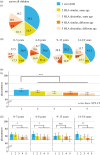Body odours as a chemosignal in the mother-child relationship: new insights based on an human leucocyte antigen-genotyped family cohort
- PMID: 32306871
- PMCID: PMC7209942
- DOI: 10.1098/rstb.2019.0266
Body odours as a chemosignal in the mother-child relationship: new insights based on an human leucocyte antigen-genotyped family cohort
Abstract
Mothers are able to identify the body odour (BO) of their own child and prefer this smell above other BOs. It has hence been assumed that the infantile BO functions as a chemosignal promoting targeted parental care. We tested this hypothesis and examined whether children's BOs signal genetic similarity and developmental status to mothers. In addition, we assessed whether BOs facilitate inbreeding avoidance (Westermarck effect). In a cross-sectional design, N = 164 mothers participated with their biological children (N = 226 children, aged 0-18 years) and evaluated BO probes of their own and four other, sex-matched children. Those varied in age and in genetic similarity, which was assessed by human leucocyte antigen profiling. The study showed not only that mothers identified and preferred their own child's BO, but also that genetic similarity and developmental status are transcribed in BOs. Accordingly, maternal preference of their own child's odour changes throughout development. Our data partly supported the Westermarck effect: mothers' preference of pubertal boys' BOs was negatively related to testosterone for the own son, but not for unfamiliar children. This article is part of the Theo Murphy meeting issue 'Olfactory communication in humans'.
Keywords: body odour; chemosensory communication; hormones; major histocompatibility complex; olfaction; parent–child relationship.
Conflict of interest statement
We declare we have no competing interests.
Figures




Similar articles
-
Interdisciplinary challenges for elucidating human olfactory attractiveness.Philos Trans R Soc Lond B Biol Sci. 2020 Jun 8;375(1800):20190268. doi: 10.1098/rstb.2019.0268. Epub 2020 Apr 20. Philos Trans R Soc Lond B Biol Sci. 2020. PMID: 32306873 Free PMC article. Review.
-
Body odours as putative chemosignals in the father-child relationship: New insights on paternal olfactory kin recognition and preference from infancy to adolescence.Physiol Behav. 2024 May 1;278:114505. doi: 10.1016/j.physbeh.2024.114505. Epub 2024 Mar 1. Physiol Behav. 2024. PMID: 38432443
-
Olfaction scaffolds the developing human from neonate to adolescent and beyond.Philos Trans R Soc Lond B Biol Sci. 2020 Jun 8;375(1800):20190261. doi: 10.1098/rstb.2019.0261. Epub 2020 Apr 20. Philos Trans R Soc Lond B Biol Sci. 2020. PMID: 32306879 Free PMC article. Review.
-
Mother-child bonding is associated with the maternal perception of the child's body odor.Physiol Behav. 2019 Jan 1;198:151-157. doi: 10.1016/j.physbeh.2018.09.014. Epub 2018 Sep 24. Physiol Behav. 2019. PMID: 30261171
-
Chemosensory communication of aggression: women's fine-tuned neural processing of male aggression signals.Philos Trans R Soc Lond B Biol Sci. 2020 Jun 8;375(1800):20190270. doi: 10.1098/rstb.2019.0270. Epub 2020 Apr 20. Philos Trans R Soc Lond B Biol Sci. 2020. PMID: 32306885 Free PMC article.
Cited by
-
There is chemistry in social chemistry.Sci Adv. 2022 Jun 24;8(25):eabn0154. doi: 10.1126/sciadv.abn0154. Epub 2022 Jun 24. Sci Adv. 2022. PMID: 35749498 Free PMC article.
-
Past, Present, and Future of Human Chemical Communication Research.Perspect Psychol Sci. 2025 Jan;20(1):20-44. doi: 10.1177/17456916231188147. Epub 2023 Sep 5. Perspect Psychol Sci. 2025. PMID: 37669015 Free PMC article. Review.
-
Children's Body Odors: Hints to the Development Status.Front Psychol. 2020 Mar 4;11:320. doi: 10.3389/fpsyg.2020.00320. eCollection 2020. Front Psychol. 2020. PMID: 32194481 Free PMC article.
-
Olfaction in the Multisensory Processing of Faces: A Narrative Review of the Influence of Human Body Odors.Front Psychol. 2021 Oct 5;12:750944. doi: 10.3389/fpsyg.2021.750944. eCollection 2021. Front Psychol. 2021. PMID: 34675855 Free PMC article. Review.
-
Interdisciplinary challenges for elucidating human olfactory attractiveness.Philos Trans R Soc Lond B Biol Sci. 2020 Jun 8;375(1800):20190268. doi: 10.1098/rstb.2019.0268. Epub 2020 Apr 20. Philos Trans R Soc Lond B Biol Sci. 2020. PMID: 32306873 Free PMC article. Review.
References
-
- Bowlby J. 1958. The nature of the child's tie to his mother. Int. J. Psycho-anal. 39, 350–373. - PubMed
-
- Lorenz K. 1970, 1971 Studies in animal and human behavior, vol. 1 & 2. (Transl. by R. Martin.) Cambridge, MA: Harvard University Press.
-
- Volk AA, Quinsey VL. 2007. Parental investment and resemblance: replications, refinements, and revisions. Evol. Psychol. 5, 147470490700500101 (10.1177/147470490700500101) - DOI
Publication types
MeSH terms
Associated data
LinkOut - more resources
Full Text Sources
Medical

